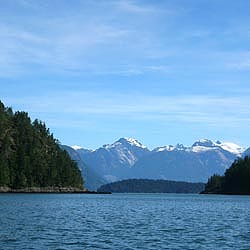The Coast Sustainability Trust II (CST) exists to help mitigate the negative effects of British Columbia provincial government land use decisions related to the Land and Resources Management Plan (LRMP) process, and the implementation of Ecosystem Based Management (EBM), on workers, contractors, First Nations and civic communities on the Central Coast, North Coast and the Queen Charlotte Islands/Haida Gwaii.

The CST is made up of two separate trust accounts and two sub-trusts.
The first is a Community Matching Fund Account. This fund is available to First Nations and civic communities in the Central Coast, North Coast and the Queen Charlotte Islands/Haida Gwaii (the CST area), and to Not-for-Profit entities that have written support from one or more First Nations or civic communities in the CST area. Applicants are generally required to match funding sought through the CST on at least a 1:1 basis. However, in order to assist communities and Not-for-Profit entities that have limited access to capital, the CST can provide up to 3:1 matching funds up to the first $50,000 of total project cost. Matching funds must be similar in nature to those provided through the CST. This requires that they be in the form of unencumbered cash contributions. Secured loans or in kind contributions, for instance, would not count as matching funds. The maximum CST funds that can be allocated to any single project is $250,000.
The Community Matching Fund and the application process is more fully described in the Community Matching Fund Guidelines.
The second account is the Eco-system Based Management Matching Account. This fund was allocated $5,000,000 effective April 1, 2007 and will be available to First Nations or civic communities, as well as workers and contractors, in the CST area that are negatively affected by the implementation of EBM. Full implementation of EBM in the CST area did not occur until March 31, 2009. The funds in the Eco-system Based Management Matching Account will not be distributed until some time after a method to determine the impact of EBM on workers and contractors has been developed.
The first sub-trust within the CST is the Eco-system Based Management Adaptive Management Sub-trust. The province of British Columbia created this sub-trust in 2009 with a contribution of $575,000 to fund the successful implementation and management of an Adaptive Management Program that supports the goals of Ecosystem Based Management.
The second sub-trust within the CST is the Landscape Reserve Planning Sub-trust. It was also created in 2009 by the province of British Columbia, with a contribution of $750,000. Its purpose is to support the First Nations represented by the Nanwakolus Council, the Coastal First Nations and the Tsimshian Stewardship Committee in Landscape Reserve Planning.
The original Coast Sustainability Trust (the Original Trust) was established in 2002 by the Province of British Columbia to mitigate adverse impacts arising from Land and Resource Management Plan (LRMP) land use planning decisions in the Central Coast, North Coast, Queen Charlotte Islands and Haida Gwaii. The Original Trust started with $35,000,000, of which $25,000,000 was allocated to a Worker and Contractor Mitigation Account, and $10,000,000 to a Matching Funds Account.
By operation of the Trust Deed that created the Original Trust, any money left in the Mitigation Account on March 31, 2005, was transferred to the Matching Funds Account. Distributions from the Mitigation Account totaled $2,933,857 to workers and $10,749,764 to contractors. Income from invested funds exceeded costs of administration, so effective April 1, 2005 $12,258,170 was transferred to the Matching Fund Account.
Again by operation of the Trust Deed that created the Original Trust, effective March 31, 2007, the Original Trust was to be wound up, and the Trustee had two years to allocate any remaining funds to an entity that had similar purposes to the Original Trust. Because there were still significant unallocated funds, as well as funds allocated to numerous specific projects that had not yet been disbursed, the Advisory Board decided to roll the Original Trust into the new CST.
Therefore, effective April 1, 2007 $13,194,063 was rolled into the new Coast Sustainability Trust II (CST) Community Matching Fund Account and $5,000,000 was rolled into the Eco-system Based Management Matching Account. In addition, $123,768 in unallocated funds in two small sub-trusts (the EBM Land Use Planning Sub-trust and the Economic, Scientific and Adaptive Management Development and Planning Sub-trust) was rolled into the Eco-system Based Management Working Group (EBMWG) Sub-trust.
Effective April 1, 2009 the EBMWG was wound up, and surplus funds of approximately $75,000 were rolled into the Ecosystem Based Management Adaptive Management sub-trust.
A Trustee and a 5 member Advisory Board administer the CST, as follows:
| Eric van Soeren | Trustee |
| Carol Kulesha | Communities Representative |
| Jeff Sheldrake | Provincial Government Representative |
| Brian Butler | United Steelworkers Representative |
| Rick Jeffery | Forest Industry Representative |
| Rob Wood | Truck Loggers Association (TLA) Representative |
In addition, there are 5 Regional Steering Committees.
The Advisory Board sets broad policy direction. Regional Steering Committees approve specific Community Matching Fund expenditures. The EBMWG approves expenditures that further the development of scientific knowledge related to the implementation of Ecosystem Based Management. The Trustee administers the accounts within the CST, chairs the Advisory Board and Regional Steering Committee meetings, and monitors community matching fund projects.
Contact Information
| Trustee: | Eric van Soeren |
| Address: | 730 Walker's Hook Road Salt Spring Island, BC V8K 1N5 |
| Phone: | 250-537-1533 |
| Fax: | 250-537-1534 |
| Email: | eric@vansoeren.net |
